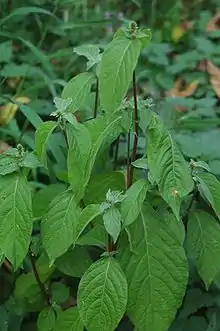Achyranthes bidentata
Achyranthes bidentata Blume (English common name: ox knee, Chinese: 牛膝 niu xi[1]) is a species of flowering plant in the amaranth family, Amaranthaceae. It occurs in India, Nepal, China, and Japan. It is the source of the Chinese herbal medicine huái niú xī. In Nepal its root juice is used for toothache. Its seeds have been used as a substitute for cereal grains in famine years.[2] The plant is used externally in the treatment of leech bites in Mizoram, India and a decoction as a diuretic.[3]
| Achyranthes bidentata | |
|---|---|
 | |
| Scientific classification | |
| Kingdom: | Plantae |
| Clade: | Tracheophytes |
| Clade: | Angiosperms |
| Clade: | Eudicots |
| Order: | Caryophyllales |
| Family: | Amaranthaceae |
| Genus: | Achyranthes |
| Species: | A. bidentata |
| Binomial name | |
| Achyranthes bidentata | |
During the Chinese Liang Dynasty, Achyranthes bidentata was used for its abortion effectiveness. Chinese folk doctors would take the juices of crushed up Achyranthes bidentata and insert them into the vagina to induce abortion.[4] This abortive technique was common among folk medicine practitioners in southern China during the Republican period.[5]
Achyranthes bidentata is now used for other things such as osteoperosis and arthritis, and known for its anti-inflammatory effects.[6]
Root
The root of this plant is known as Achyranthis Radix [Or AR in short].[7]
References
- "Achyranthes bidentata". Germplasm Resources Information Network. Agricultural Research Service, United States Department of Agriculture. Retrieved 2008-02-11.
- "Achyranthes bidentata - Blume. : Niu Xi". Plants For A Future.
- Sharma, Hemanta Kumar; Chhangte, Lalrampari; Dolui, Ashoke Kumar (2001). "Traditional medicinal plants in Mizoram, India". Fitoterapia. 72 (2): 146–161. doi:10.1016/S0367-326X(00)00278-1. PMID 11223224.
- Jiang, Zhou; Qian, Jun; Dong, Haiyan; Yang, Jingyi; Yu, Xiaobo; Chen, Jianzhong; Chen, Hongning; Shi, Qing; Jia, Lee. "The traditional Chinese medicine Achyranthes bidentata and our de novo conception of its metastatic chemoprevention: from phytochemistry to pharmacology". nature.com.
- Rodriguez, Sarah Mellors (2023). Reproductive realities in modern China : birth control and abortion, 1911-2021. Cambridge, United Kingdom: Cambridge University Press. p. 60. ISBN 978-1-009-02733-5. OCLC 1366057905.
- Marcone, Massimo F.; Firouz, Jahaniaval; Hamid, Aliee; Yukio, Kakuda. "Chemical characterization of Achyranthes bidentata seed". 81 (1): 7.
{{cite journal}}: Cite journal requires|journal=(help) - Hyun SW, Lee TG, Song SJ, Kim CS (28 June 2021). "Evaluation of oral toxicity and genotoxicity of Achyranthis Radix extract". J Ethnopharmacol. 274: 113944. doi:10.1016/j.jep.2021.113944. PMID 33711437. S2CID 232217533.
External links
 Data related to Achyranthes bidentata at Wikispecies
Data related to Achyranthes bidentata at Wikispecies Media related to Achyranthes bidentata at Wikimedia Commons
Media related to Achyranthes bidentata at Wikimedia Commons